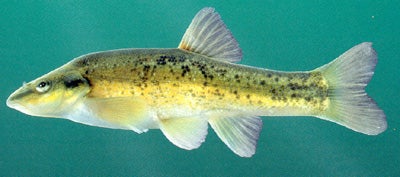BLACKNOSE DACE
SCIENTIFIC NAME: Rhinichthys atratulus
CHARACTERISTICS: The deep, rounded body of the blacknose dace is covered with small scales, tapers toward a deep caudal peduncle, and strongly arches downward from the dorsal fin to the tip of the snout. Numerous black-brown blotches of various sizes are scattered over the entire body. The dark lateral stripe extends from the snout to the tail, and a small dark spot is present at the base of the caudal fin. The pointed snout overhangs the mouth, which has a small barbel in each corner. A broad frenum connects the upper lip with the snout. Live breeding males have a deep golden yellow body color that is darker on the back and lighter on the lower sides and venter, with yellow-white paired fins and a yellow-orange stripe below the lateral band.
ADULT SIZE: 1.6 to 2.6 in (40 to 65 mm)
DISTRIBUTION: Rhinichthys atratulus is found throughout upper Mississippi River drainages from Minnesota to Pennsylvania and in Canada from Nova Scotia to Manitoba. It is also found in upland streams of Atlantic slope drainages from Georgia northward. In the Mobile basin it occurs widely in the upper Coosa River system and has been reported from two locations in the Black Warrior River system. In Alabama it is commonly found throughout the Tennessee River drainage. Three subspecies are recognized (Hubbs, 1936): R. a. atratulus occurs along the Atlantic slope, R. a. meleagrisin the central and northern interior, and R. a. obtusus from the lower Ohio to the Mobile basin.
HABITAT AND BIOLOGY: Blacknose dace prefer rocky riffles and riffle runs of small, upland headwater streams or spring-fed streams with clear water. Traver (1929) characterizes them as swift, active fishes that can easily elude would-be captors. Spawning occurs from April through June, with eggs deposited in sand or gravel substrates. Schwartz (1958) reports midwater spawning pools for R. a. obtusus, whereas the other subspecies apparently spawn in riffles or pools, generally on the bottom in gravel or in bedrock cavities. Blacknose dace prefer to eat aquatic insects, but they will also consume algae and plant material.
ORIGINAL DESCRIPTION: The blacknose dace was described by Hermann in 1804.
ETYMOLOGY:
Rhinichthys means snout fish.
Atratulus means clothed in black, referring to this species" body color.
The copyrighted information above is from Fishes of Alabama and the Mobile Basin.






